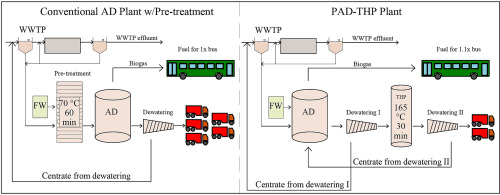Water Research ( IF 11.4 ) Pub Date : 2018-01-04 , DOI: 10.1016/j.watres.2018.01.008 Kine Svensson , Oda Kjørlaug , Matthew J. Higgins , Roar Linjordet , Svein J. Horn

|
Post-anaerobic digestion (PAD) treatment technologies have been suggested for anaerobic digestion (AD) to improve process efficiency and assure hygenization of organic waste. Because AD reduces the amount of organic waste, PAD can be applied to a much smaller volume of waste compared to pre-digestion treatment, thereby improving efficiency. In this study, dewatered digestate cakes from two different AD plants were thermally hydrolyzed and dewatered, and the liquid fraction was recirculated to a semi-continuous AD reactor. The thermal hydrolysis was more efficient in relation to methane yields and extent of dewaterability for the cake from a plant treating waste activated sludge, than the cake from a plant treating source separated food waste (SSFW). Temperatures above 165 °C yielded the best results. Post-treatment improved volumetric methane yields by 7% and the COD-reduction increased from 68% to 74% in a mesophilic (37 °C) semi-continuous system despite lowering the solid retention time (from 17 to 14 days) compared to a conventional system with pre-treatment of feed substrates at 70 °C. Results from thermogravimetric analysis showed an expected increase in maximum TS content of dewatered digestate cake from 34% up to 46% for the SSFW digestate cake, and from 17% up to 43% in the sludge digestate cake after the PAD thermal hydrolysis process (PAD-THP). The increased dewatering alone accounts for a reduction in wet mass of cake leaving the plant of 60% in the case of HRSD cake, in addition to this increased VS-reduction will contribute to reduce the mass of wet cake.
中文翻译:

厌氧消化后污泥和食物垃圾的热水解:对甲烷产量,脱水性和固体减少的影响
厌氧消化(AD)已建议采用厌氧后消化(PAD)处理技术,以提高工艺效率并确保有机废物的湿化。由于AD减少了有机废物的数量,因此与消化前处理相比,PAD可以应用于体积更小的废物,从而提高了效率。在这项研究中,将来自两个不同AD工厂的脱水消化饼进行热水解和脱水,然后将液体馏分再循环到半连续AD反应器中。与来自工厂处理源分离的食品垃圾(SSFW)的滤饼相比,热水解在甲烷产量和脱水能力方面对来自处理废物活性污泥的滤饼的效率更高。高于165°C的温度可获得最佳结果。与固相反应相比,在中温(37°C)半连续系统中,后处理可将甲烷的体积产率提高7%,并将COD的降低从68%提高至74%。常规系统,在70°C下对进料底物进行预处理。热重分析的结果表明,脱水的消化饼的最大TS含量从SSFW消化饼的34%上升到46%,在PAD热水解过程(PAD)后从污泥消化饼的17%上升到43% -THP)。就HRSD滤饼而言,仅增加的脱水量就使离开工厂的滤饼湿质量降低了60%,此外,这种VS降低的增加将有助于减少湿滤饼质量。











































 京公网安备 11010802027423号
京公网安备 11010802027423号